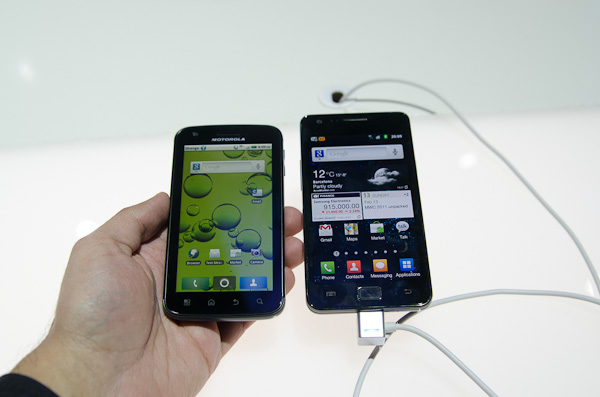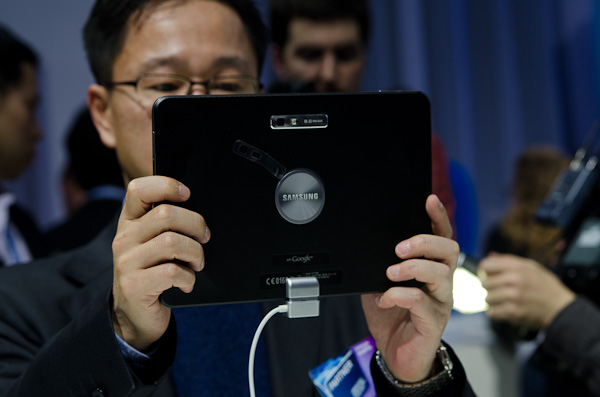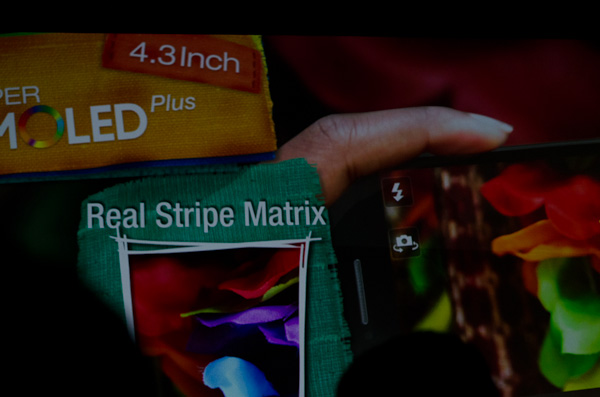Hands on with the Samsung Galaxy S II & Galaxy Tab 10.1
by Anand Lal Shimpi on February 13, 2011 8:01 PM EST- Posted in
- Smartphones
- Samsung
- MWC 2011
- Galaxy S II
- Mobile
- Tablets
- Trade Shows
In a not completely unexpected move Samsung Mobile announced that it would be working with NVIDIA on two different projects. First and foremost is the Samsung Galaxy Tab 10.1. This 10.1" Honeycomb tablet uses NVIDIA's Tegra 2 SoC (just like LG's Optimus Pad and Motorola's Xoom). The big news isn't the fact that it's a 10-inch Android tablet, but that it's not using a Samsung SoC.
As the reference platform for Honeycomb, NVIDIA's Tegra 2 makes a lot of sense for Samsung. The fact that Samsung went from reference platform for Gingerbread to having to partner with NVIDIA on Honeycomb doesn't bode very well for its SoC team.
I had the opportunity to play around with the Galaxy Tab 10.1 after Samsung's press conference. If you've ever used a Galaxy S phone like the Fascinate you'll know that it feels: 1) plasticky, 2) light and 3) just a little cheap. The Galaxy Tab 10.1 is like a giant Fascinate, but it doesn't feel all that cheap to me - just light.
The weight is comfortable, especially coming from an iPad. The OS is responsive however I get the impression that Honeycomb is still a bit early. Despite GPU acceleration everywhere I noticed some choppy scrolling and laggy transitions. The unit I was playing with even managed to reboot in the middle of me messing with the camera. These are all issues you'd expect from pre-release software so I'm not too concerned.
I think it's still too early to tell how well these Honeycomb tablets will do in the market. I need to see final software to get a better idea. Soon enough I hope...
The Galaxy S II
Despite turning to NVIDIA for the Galaxy Tab 10.1 (and an unannounced future Samsung superphone), Samsung did introduce the Galaxy S II based on an unnamed SoC (the assumption is that it's Samsung's own Orion SoC).
The Galaxy S II features a 4.3" Super AMOLED Plus display (full stripe matrix, not PenTile) with what appears to be a 800 x 480 resolution. The phone measures only 8.49mm thick and weighs a meager 116g. That's 85% the thickness and 91% of the weight of a Samsung Fascinate.
Inside the Galaxy S II is a dual-core (Cortex A9) SoC running at 1GHz. A 4-core GPU (Update: we listed a 4-core PowerVR SGX 544 earlier, which is incorrect) and a HSPA+ 21Mbps modem. Powering all of this is a 1650mAh battery, a 10% increase in battery capacity vs. the Samsung Fascinate.
The Galaxy S II supports NFC, 1080p30 recording and playback and features a 8MP rear facing camera with LED flash. On the front you've got a 2MP camera. WiFi Direct is also supported, which will be used to enable wireless syncing to your desktop over WiFi.
Samsung includes the latest version of its TouchWiz UI (4.0), which includes an entire suite of remote location and theft recovery tools. You can remotely locate your phone, lock it and of course track it all on the web. You can also have your phone SMS you if someone swaps out the SIM as well as remotely monitor what calls are made with the phone.
Rounding off the list of supported features are a 3-axis gyroscope and accelerometer. Samsung also boasts hardware encryption on the Galaxy S II but it wasn't clear in what sense (perhaps real time NAND encryption?).

Motorola Atrix 4G (left) vs. Samsung Galaxy S II (right)
I spent some time with the Galaxy S II after Samsung's press conference and I can confirm that it is both very thin and very fast. The Galaxy S II will launch with Gingerbread and as a result scrolling through apps is smoother than even on the Tegra 2 based Atrix 4G.
Overall the Galaxy S II felt like a slightly faster, slightly smoother Atrix 4G. We'll have to get one in house to really pit it up against NVIDIA's flagship. The Gingerbread advantage is undeniable though.
























25 Comments
View All Comments
eddman - Sunday, February 13, 2011 - link
Where did that come from? If true, then it probably has the fastest GPU among cortex-A9 SoCs. I'd really like to see some graphics benchmark numbers.sarge78 - Sunday, February 13, 2011 - link
Its a 4 core mali gpuMike1111 - Sunday, February 13, 2011 - link
This got to be a mistake. The Orion has a Mali 400 GPU (ARM calls it a quad-core). Maybe this got mixed up. A 4-core SGX544 seems really unlikely for the Galaxy S 2.rcocchiararo - Sunday, February 13, 2011 - link
And GSMARENA is saying that it has an Adreno 205 :PMike1111 - Sunday, February 13, 2011 - link
Release dates and prices for the Galaxy Tab 10.1 and Galaxy S 2?And how come Honeycomb is not done yet when the Xoom is supposed to be available in less than two weeks?
SlinkyDink - Sunday, February 13, 2011 - link
the link to the Galaxy Tab photos is broke.geostep - Sunday, February 13, 2011 - link
I've owned a Captivate (just another Galaxy S phone) for 6 months now, and this thing is soooo buggy. The file system is RFS, it causes OS stalling issues. The GPS, takes minutes to get a satellite lock. The power button is on the opposite side of the phone from the volume buttons, making it impossible to turn it on without changing the volume. The camera doesn't have a flash. I'm experiencing more app. crashes than most of my friends, also on Android 2.1 with the same apps. It's 2011 and they still don't have a froyo update to Android. In essence, they just don't care about you after they release a product, because they're on to developing the next product. I would never recommend this product to anyone. All this product makes me do is think about my old iPhone 3GS. So why did I buy to begin with? The spec sheet looked good, just like the spec. sheet for the Galaxy S2 does right at this moment. Fight the urge and save yourself a lot of headache. Please don't take my word for it, do the research over at XDA developers and other forums. I may stick with Android, but I will not be returning to Samsung, though I've said that before. A strong spec. sheet is a hard thing to resist.Megneto - Monday, February 14, 2011 - link
I've used Galaxy S for 4+ months now, and my experience has been absolutely horrendous, different things will crash at any given time just for the fun of crashing. Phone will crawl such slow response to the point of un-usability without any apparent reason or any applications running. Default Task Manager will crash every now and then during use; and sometimes the whole thing just hangs up, and I need to pull out the battery and then reinsert it. It never connects to PC through USB no matter what I do (and I've tried connecting it to half a dozen PCs / Notebooks). I did manage to get around this issue partially by connecting via Wifi, but it has its limitations.It has been such a disappointment after having used Omina i900 for almost 3 years, which never missed a beat and was a solid product. I doubt that I'll bother considering any more android based phone in near future. I am seriously thinking about chucking this thing out and getting a WP7 (once they roll out the updates) or iphone 5 (?).
softdrinkviking - Monday, February 14, 2011 - link
I am a bit surprised at the (so far) universal loathing of samsung phones in the comments here.I'm not defending them, I have never used a samsung phone before, but I have never read so much poor feedback about their products before.
I was thinking this phone looked pretty nice and maybe would buy it, but now I guess I should think more carefully!
I guess there should be an updated droid X on the way if I want to get big screen (which is what I really want).
strikeback03 - Monday, February 14, 2011 - link
I had a Samsung Alias for 2 years, and for a featurephone I was very happy with it. Given the reboot issues a lot of LG featurephones on Verizon had at the same time I think Samsung did well. That said they have been way too slow updating the Galaxy S line in the USwho knows how much is their fault and how much the carriers but it has been bad. And the GPS issue looks like it might have been an engineering mistake along the lines of the iphone 4 antenna, but it doesn't help their customers think better of it in any way.